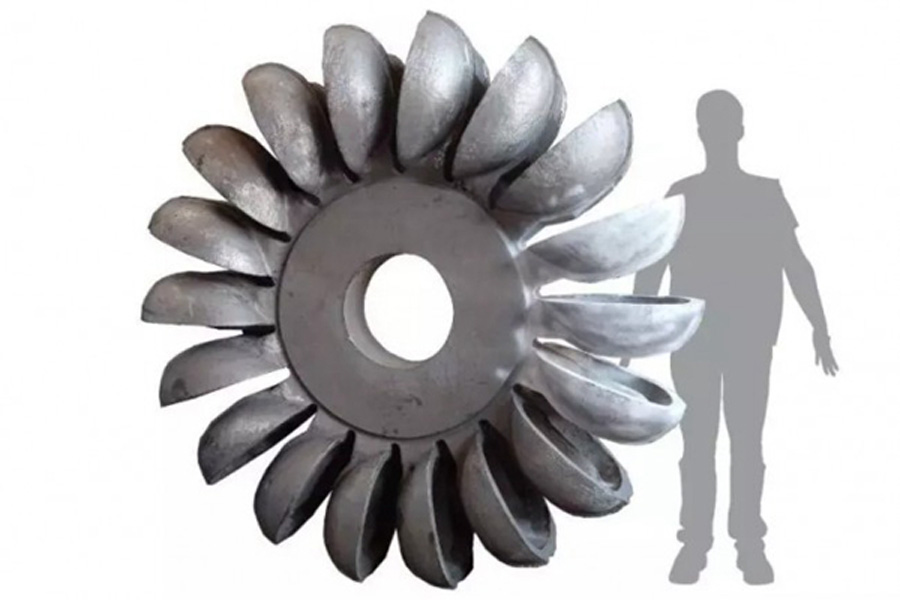
The impulse turbine is one of the four major models of hydroelectric power generation. The runner is the key component of the impulse hydropower plant. However, because the impulse turbine runner is equipped with 20-25 curved water buckets on the hub, its curved shape is very complex. At present, the runners developed by domestic enterprises are mainly based on the model runner profile in the 1980s abroad, and are developed by the process of integral casting and manual polishing.
According to Harbin Electric Machinery Factory Co., Ltd. of Harbin Electric Group, China’s first additive-manufactured impulse turbine runner was successfully developed and delivered by the company, marking the entry of the research and application of Harbin Electric’s additive manufacturing (3D printing) technology. A new stage of development.
The big challenge of the water wheel
The Harbin Electric Group Motor Company entered the field of 3D printing in 2013. It was the earliest unit to carry out 3D printing technology application research in China. In 2015, it successfully manufactured the first domestic 3D printed non-metallic model that can be applied to the hydraulic test of model turbines. Wheel, completed the feasibility study and pre-development of the model runner metal 3D printing technology.
Based on the 3D printing project team of the model runner, the Electric Machinery Company of Harbin Electric Group established the “Hydraulic Turbine Runner Additive Manufacturing Double Innovation Team”, and relied on platforms such as the State Key Laboratory of Hydropower Equipment and the National Hydropower Equipment Engineering Technology Research Center. The development of the industry, guided by market demand, is facing the focus and difficulties of product manufacturing in the industry, taking the most representative impact runner 3D printing-additive manufacturing in hydraulic turbine runners as a breakthrough point, and in-depth application research and development innovation.
Attempt to overtake in a curve
The application of this technology in the manufacturing of such large-scale structural parts is an important direction for the current research and development of additive manufacturing technology, and it is also facing many technical problems that need to be overcome. The successful development of China’s first additive-manufactured impulse runner and the operation verification of future power stations can provide effective and feasible new solutions for hydraulic development of ultra-high head and ultra-large-capacity impulse runner manufacturing.
High-safety impact runner
According to the structural characteristics and operating conditions of the impact runner, the project team created a highly safe additive manufacturing structure, developed a robot-based additive manufacturing process for runners, and formed a complete and independent intellectual property right. Additive manufacturing technology for runners.
The subsequent manufacturing process verifies the application of this technology, greatly reduces the manufacturing cost, cycle and difficulty of the impact runner, has good economy, meets the research and development expectations, and has a broad market prospect. In the near future, the additive-manufactured impact runner can be installed and operated, and its operational safety, life and efficiency will be further evaluated and verified.
The design process of the water wheel requires the organic combination of CAD/CAM/CAE/CFD technology, through process simulation and analysis of the rigidity and strength of the runner, and using the results of the analysis, the structure of the runner is modified until the hydraulic performance and structure are obtained. A runner with excellent reliability and manufacturability. In addition to the direct 3D printing to achieve the manufacture of water wheel runners mentioned in the article, the manufacture of large water wheel runners has also been realized internationally through the combination of 3D printing sand molds and casting. When talking about the application of the combination of 3D printing and casting, it is necessary to understand the advantages of 3D printing. 3D printing has two major characteristics: 1. It is modelless, and the corresponding advantage is to serve as a shortcut to the R&D trial production stage and accelerate the iterative process. Reduce R&D costs; 2 is insensitive to product complexity and cost, and the corresponding advantage is suitable for innovative and subverting product design, making product design dominated by functional realization. The common misunderstanding in the domestic foundry industry is that it only takes advantage of the first advantage of 3D printing and uses 3D printed sand molds or 3D printed PMMA investment molds in the trial production and development stage of products, that is to say, the products processed are still traditionally designed products. Instead of using 3D printing from the source for the design of innovative products.
The biggest advantage of 3D printing is to create designs that cannot be achieved by traditional methods, including thin-walled and complex shapes. For the automotive field, a specially designed cooling system can be 3D printed (such a design passes Traditional manufacturing processes can not be manufactured), so as to achieve higher product performance.
Generally speaking, the larger the casting size, the more sand cores need to be manufactured. 3D printing technology used in the manufacture of large-scale casting sand molds has challenges such as sand core exhaust, sand core fixing, and external cooling iron setting and fixing.
Not only that, these sand molds usually have to meet the requirements of ultra-high temperature, ultra-thick and wide section, high pressure, clean, and non-destructive during the metal casting process. In this regard, voxeljet successfully manufactured the 3.2-ton Pelton turbine impeller through cooperation with the pump manufacturer.
The characteristic of voxeljet is the large-format 3D printing technology based on binder jetting. For this Pelton-type turbine impeller, due to its huge size, it usually needs to be divided into different parts through traditional manufacturing methods. In the casting process, 18 blades are welded to the impeller by welding. This process is very complicated, time-consuming and expensive.
Through voxeljet-Voxel large industrial-grade 3D printer VX4000 completed all the work at one time, the printing area of VX4000 is 4,000 x 2,000 x 1,000 mm (length x width x height). The printing process takes 72 hours, after which only KBL’s proprietary coating technology is required for post-processing.





